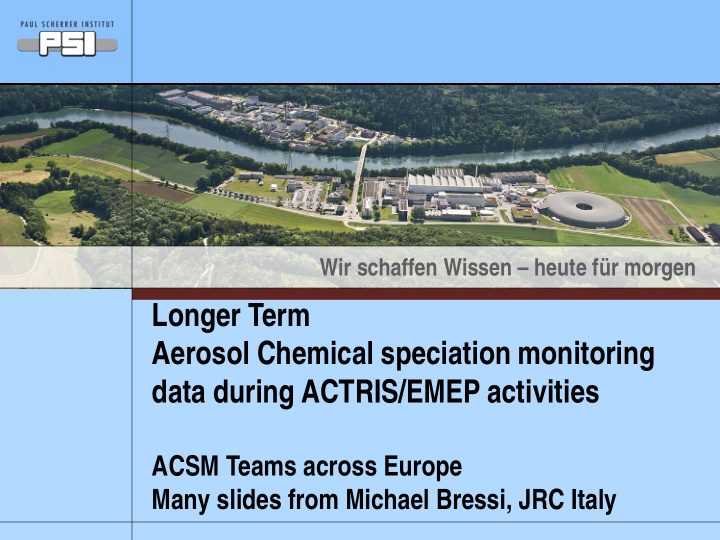



Wir schaffen Wissen – heute für morgen Longer Term Aerosol Chemical speciation monitoring data during ACTRIS/EMEP activities ACSM Teams across Europe Many slides from Michael Bressi, JRC Italy
ACSM stations • Half hourly measurements of submicron organic mass, sulfate, nitrate, ammonium during at least a season, ideally for full years • Organic mass spectra can be used to derive sources and components of organic aerosols (traffic, biomass burning, coal burning, cooking, secondary organic aerosols) Sam pling sites + 20 potential sites in 12 different countries + Site types: 2 remote/ high altitude, 2 urban background, 6 coastal, 10 rural background sites ? Heterogeneity of sampling site locations, types, altitude, etc. 2 http://www.psi.ch/acsm-stations/acsm-station PSI, 02.07.2015 Seite 2
MATERI AL AND METHODS Data coverage From 1 Feb. 2011 to 2015 1 2 http: / / www.psi.ch/ acsm-stations/ overview-full-period Assum ptions: If data coverage> 1.5 months in a given season data representative of the full season 1 (Spring= MAM, Summer= JJA, etc.) 3 PSI, 02.07.2015 Seite 3
PRELI MI NARY RESULTS Chem ical com position of NR-PM 1 + Organics are the m ain com ponent of NR-PM 1 ( m in 3 1 % , m ax 6 2 % , m edian 5 2 % ) 4 PSI, 02.07.2015 Seite 4
Chem ical com position of NR-PM 1 + Large variety of sources and processes leading to the formation of organics no clear trend + Nevertheless: highest [ Org] relative contribution in Nordic countries (FI, NO) PSI, 02.07.2015 Seite 5
Composition overview paper led by M. Bressi, JRC • GOALS Analysis of relative composition per season Daily cycles of the various components in different seasons Analysis of relative composition as a function of concentration or other parameters Current goal: submission of paper in January 2016. Data will then become completely available PSI, 02.07.2015 Seite 6
INTERCOMPARISON EXERCISE within ACTRIS Comparison of 13 ACSMs near PARIS Will be published in AMTD very shortly by Crenn et al. PSI, 02.07.2015 Seite 7
Source apportionment AMT, 2013 ACP, 2014 PSI, 02.07.2015 Seite 8
SoFi programmed in Igor as an efficient evaluation tool gets widely spread This year we had two workshops with a total of around 60 people from all around the world, mostly Europe and ACTRIS related Important here: This tool is not only for aerosol mass spectrometer data but also for classic data sets. Lots of convenient plots are available. There is a free version although a user fee is being discussed to be able to update the tool with additional features. At the moment we ask to be involved in the first one or two research applications/publications. PSI, 02.07.2015 Seite 9
Overview of relative organic aerosol sources (1 month data) Crippa et al.,, ACP, 2014 PSI, 02.07.2015 Seite 10
First model evaluations for organic aerosols • VBS type models clearly Feb/March 2009 September/October 2008 more successful to model organic aerosols • Most models in EURODELTA underestimate organics, especially SOA Fountoukis et al., ACP, 2014 PSI, 02.07.2015 Seite 11
Comparison exercise near Paris Froehlich et al., AMTD, 2015 .. Accepted for AMT .. Watch out this or next week PSI, 02.07.2015 Seite 12
FULL YEAR datasets Methods to analyze a full year is still under development. AURO-SoFi (Automatic rolling source finding) Perform source apportionment with ME-2 over 1-2 months periods and roll this window with a step of e.g. one day around the year or around daily temperature sorted data. PMF/ME-2 over the whole year clearly have limitations because different SOAs do not unmix easily. One performs for each time window around 100 ME-2 runs with different constraints (e.g. fixing a traffic organic aerosol factor at different degrees) and chooses the best solutions according to chosen criteria (e.g. cooking peak at noon, correlations of traffic organics with NOx) One keeps several results for the same day which allows to assess the uncertainty . PSI, 02.07.2015 Seite 13
FUTURE • FIRST OVERVIEW SOURCE APPORTIONMENT PAPER led by PSI: submission mid-2016 to end 2016 (optimistic) • Another phase of EURODELTA or similar model evaluation exercises. Important: Opportunity for development and assessment of Volatility Basis Set or other modern schemes for organic aerosols • Also more coordinated future measurements within ACTRIS 2 and hopefully COST action • Combination with equivalent black carbon measurements would be very useful (ideally multi-wavelength to distinguish traffic from wood burning) PSI, 02.07.2015 Seite 14
IDEAL FUTURE CAMPAIGN • COMBINATION OF THE ACSM data sets with off-line analyses of organic markers, off-line AMS and other methods over full years. This could also be done for twin sites (rural/urban) PSI, 02.07.2015 Seite 15
Combination of new and classic off-line methods Sources of PM 2.5 North South PSI, 02.07.2015 Seite 16
IDEAL FUTURE CAMPAIGN to address organics • COMBINATION OF THE ACSM data sets with off-line analyses of organic markers, off-line AMS and other methods over full years to cover much more of Europe. This could also be done for twin sites (rural/urban). • Necessary funding per station (100 Hi-Vol filters across the year): around 20’000-30’000 Euros per station and year To be considered in any case: Freeze Hi-Vol-Filters over longer term for future analyses. PSI, 02.07.2015 Seite 17
Recommend
More recommend